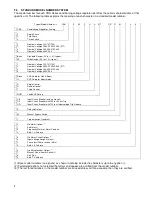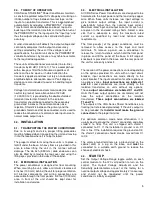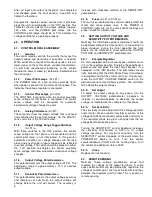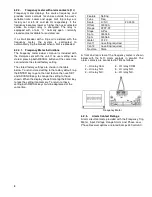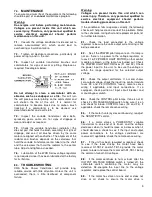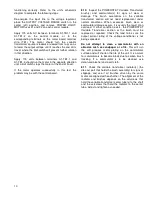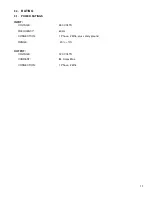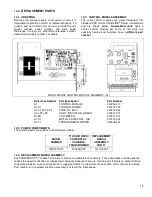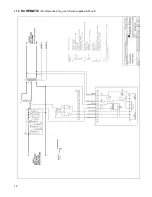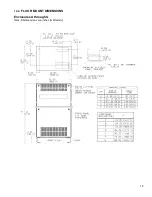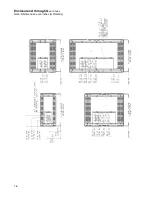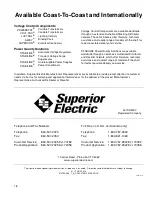
6
After all input and output connections are completed
and checked, place the front panel(s) in position and
tighten the fasteners.
Energize the regulator power source and, if provided,
place the unit’s circuit breaker in the "ON" position. The
voltmeter should indicate the output voltage (approx.
120 volts), and the POWER pilot lamps and the
CONTROL pilot lamps should be lit. This indicates the
voltage conditioner is operating properly.
5.0.
OPERATION
5.1. CONTROL MODULE ASSEMBLY
5.1.1.
General
The control modules contain the circuitry that sense the
output voltage and determine if correction is needed.
When correction is required this circuit sends a raise or
lower signal to the motor driven variable transformers.
To eliminate unauthorized tampering of the control
module the items marked (
♦
) below are located behind
the front panel.
5.1.2.
Power Pilot Lamps
(A1-LP1)
The POWER lamp on each control assembly lights
when power is present for the motor on that phase. This
indicates the voltage regulator is energized.
5.1.3.
Control Pilot Lamps (
A1-LP2)
The CONTROL lamp lights when the control assembly
sense voltage for that phase is energized. The control
sense voltage must be energized for automatic
correction of voltage changes to occur.
5.1.4.
Analog Voltmeters
(A1-M1)
These meters show the output voltage that is sensed
and controlled by the control module. For the CRA141
series units this is the 120 volt output.
5.1.5.
Output Voltage Range Toggle Switches
(A1-S1)
♦
With these switches in the OFF position, the control
sense voltage for that phase is disconnected and the
control pilot lamp is not illuminated. In this position
automatic correction for voltage changes will not take
place and any change in input voltage will be reflected
in output voltage. The switch should be placed in either
the “120” position to energize the control assembly
sense voltage and allow automatic correction of voltage
changes.
5.1.6.
Output Voltage Potentiometers
♦
This potentiometer sets the output voltage (X1-X2). The
adjustment range is approximately ± 10% of nominal
output voltage.
5.1.7.
Sensitivity Potentiometers
♦
This potentiometer adjusts the output voltage accuracy
and therefore set how much the output voltage will
change before the unit will correct. The accuracy is
increase with clockwise rotation of the SENSITIVITY
potentiometer.
5.1.8.
Fuses
(A1-F1 to A1-F4)
♦
The four fuses located on the control module protect the
motor and sense power lines. If the POWER or
CONTROL lights are not lit, and all control settings are
proper, check for a blown fuse.
5.2. SETTING OUTPUT VOLTAGE AND
SENSITIVITY POTENTIOMETERS
Normally, the CRA Series power conditioner should not
be operated without the front panel(s) of the cabinet in
place. However, during the initial operation the front
panels can be removed to allow setting the OUTPUT
VOLTAGE and SENSITIVITY potentiometers.
5.2.1.
Energize Regulator
On units equipped with a manual bypass switch ensure
it is in the regulator position. Energize the conditioner’s
power source and place the input circuit breaker, if so
equipped, in the "ON" position. The pilot lamps should
light, indicating that the CRA Series Power Conditioner
is energized and that the control unit is on. If necessary,
move the OUTPUT VOLTAGE RANGE switch to the
desired nominal output voltage position. The voltmeter
will indicate the output voltages.
5.2.2.
Set Output
To adjust the output voltage on any phase, turn the
OUTPUT VOLTAGE potentiometer clockwise to
increase or counterclockwise to decrease the output
voltage, as indicated on the voltmeter for that phase.
5.2.3.
Set Sensitivity
The sensitivity must be adjusted if the voltage regulator
hunts (motor driven variable transformer section of the
voltage conditioner continually cycles back and forth) or
if the regulator allows too great a change from the set
voltage before correction occurs.
Turning the SENSITIVITY control clockwise increases
the sensitivity to maximum (± 0.75% to 1% output
voltage accuracy). For maximum sensitivity, turn the
SENSITIVITY control clockwise to the point where the
POWERSTAT begins to hunt. Turn the control
counterclockwise (CCW) until the hunting stops. Turn
the control an additional 1/8 turn CCW.
5.2.4.
Close
Replace the front cover(s).
5.3. REMOTE SENSING
Normally, these voltage conditioners sense and
regulate the voltage at the output terminals, In some
cases better control can be obtained by regulating the
voltage at another point, such as at the end of long lines
between the regulator and the load. This is known as
remote sensing.




